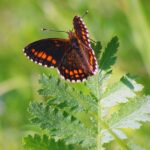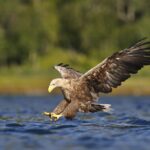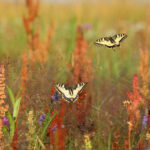There is no place in Europe where You can meet all this mammals – wild bears, wolves, lynxes and flying squirrels. There are currently 65 different species of mammals living in Estonian forests, among them 500–600 brown bears, over 150 wolves, around 700–800 lynxes, 20,000 beavers, 20,000 wild boars, 12,000 elk plus deer and other wild animals. Unbelivable numbers for such a small country. The most endangered example is the European mink, several species of dormouse and the flying squirrel. A species typical of taiga forests, the flying squirrel, still survives here but it is extremely rare. Discover the wolf, lynx and bear habitats in Alutaguse. The biggest forest area in Estonia, situated in the Northeast of the country, close to the Russian border. Estonian forests and woodlands are well-known in Europe for the number of mammals living there. There are 3–4 times more bears per square kilometre living here than in Finland.
Bears
hibernate from mid-November until the end of March. The best time to go bear-watching and to take photos at the feeding station is from May until mid-July when the nights are white. In August bears can find enough food themselves and will not come to the feeding place. They come to the feeding places again in September and October to gather strength for hibernating.
The biggest predator in Estonian woods. Currently, more than 800 bears were counted in Estonia, and their number is growing significantly. The bears living in Estonia belong to the average size race, weight is between 90–340 kg
Wild Boars
are regularly provided with food by hunters throughout the year. Therefore it is quite easy to watch them before sunset at the feeding sites.
The wild boar arrived in Estonia in the 1920s. Nowadays it has spread all over the country. The boars who usually live alone, join the sounder during mating season when angry fights take place and the weaker are pushed aside. The winner will impregnate all the sows of the sounder. Maturity is achieved early, in favourable conditions also piglets may be impregnated. The piglets are born in the period from March until May. In autumn, piglets make up more than 50% of the population.
Elk
The best time for Elk-watching is September and October during the mating season. Another good period is April when the calves from the previous year will be evicted by adults before the next generation is born.
Although Estonia has a remarkable amount of different animals, many factors have to be taken into account in order to see them.
The biggest animal in our forests. Males fight each other for the right of being the leading male. The leading male can inseminate up to seven females during the mating season. The natural enemies of the Moose are wolf and bear.
Siberian flying squirrel
The best time to observe flying squirrels are from May to early August when the white nights give better opportunities to see this nocturnal mammal. In Europe they can only be found in Estonia and Finland.
The flying squirrel has a unique appearance. It has big eyes and there is a fold of skin between the fore- and hindlimbs. Big eyes are useful for seeing in the dark at night because the flying squirrel is active mainly at nights. The flying squirrel does not actually fly but glides: jumping into the air it stretches the fold of skin between its limbs and then glides for about twenty meters or so. It guides its flight with its tail. Before landing on the tree, it brakes by bending the tail down. After landing on the tree it runs straight to the other side of the tree to escape possible trackers. It has a lot of enemies, e.g. the martens, the strixes, etc.
The flying squirrel lives almost all of its life on top of trees, coming to the ground only in case of extreme need. As a shelter it prefers a forest with old trees that has many tree hollows where to build its nest. The flying squirrel eats the buds of trees, young branches, seeds, etc. It also gathers food supplies for winter to survive the cold period.
NB! As flying squirrels are endangered, their observation and being near to their habitats is only allowed with a local expert.
The wolf
has a strong sense of smell and hearing, they also see better than other canines. The wolf is mainly a nocturnal animal, its regime may vary depending on the habitat and season.The most feared predator in the Estonian forest. The wolf is called the nurse of the forest in Estonian folklore because it hunts sick or injured animals and limits the population of rodents and hoofed animals.
Wolves live in their different periods of life either in a pack or as couples. They move in packs from autumn to spring. The pack is formed from an old male wolf and female wolf and their cubs from past year and current year. The female is the leader of the pack. In the winter family packs can form also bigger joint packs.
In the summer wolves which are raising their cubs usually live in pairs. Outcast animals or also some occasional ’rebellious’ young males can also live alone. The power hierarchy plays an important role in case of wolves and the position of every animal in the pack is determined already in early age. The howling of the wolf can be heard especially well in January and February. The wolf is a monogamous animal, the couples that are formed last until the end of their lives. The couple also takes care of the cubs together. Estonia has been a home for wolves already for more than 10,000 years. In recent years the population of wolves has increased. Hunters have not managed to use all the hunting permits issued by the government because it is difficult to hunt wolves. This is good in some respects because due to that the wolf population will grow even more. But it is not good news for sheep farmers who complain about the damage caused by the wolves.
Lynx
February and March are good months for observing lynx. The only feline living locally in Estonian nature.
Meeting the lynx is never very easy as their territory may extend up to 200 square kilometres. In addition, it has a hidden way of life and moves mainly at nightfall and at night. In winter it is easy to examine its activity based on its footprints. The lynx searches for food early in the morning and in the evening, at night it rests. The lynxes, just like other predators, do not hunt for strong healthy animals. Wolf is the biggest competitor for the lynx when it comes to diet. Wolves’ habitat is bigger than the lynxes’ and more even. Where there are a lot of wolves, there are few lynxes. The lynxes prefer to always use the same tracks and to hunt in a specific area. Although the lynx is a good climber, it prowls for its prey on the ground. They lynx is a big animal that can weigh up to 25 kg.
Even though one male has many ’wives’, the father takes part in raising the cubs and teaches, feeds and grooms them sometimes. Lynx cubs stay with their mother for several years, they only part due to food shortage.
The lynx used to be widespread all over the Northern hemisphere but by now they have been destroyed by man in many European countries. There are still plenty of lynxes left in Estonia (almost a thousand) and because of that it is even allowed to hunt them. Together with an experienced game warden and with good luck it is possible to also see the lynx.
The mating season is in February and March. One female can be chased by up to 5 males. The female is ready for mating for three days, gestation lasts 63–74 days. There are usually 1–6 in offspring, mostly 2–3. They are usually born in May, weighing about 300 grams, and develop eyesight by the 12th day. For two months they feed on mother’s milk, the offspring remain with the mother until the end of their first year. They become mature at the age of two. In addition to humans, the enemy of the lynx is the wolf.
Beavers and otters
There are about 20,000 beavers and 2000 otters in Estonia.
Spotting beavers is not too difficult in favourable weather conditions, but during storms and heavy rain they may retreat into their lodges for many days. The best time for beaver watching is from April to August.
The beavers have a semi-aquatic way of life. They build their home on the shores of a lake or a river. The colour of their fur varies from light brown to black. Its flat tail that seems to be crushed flat from the top is covered in scales. The beaver uses its tail in the water as a steering wheel, sometimes also as a paddle and to give signals by slapping the water with its tail. Sometimes older beavers give their offspring a ride on the tail. Beaver fur is impermeable. It consists of a very thick and soft underfur that is covered with a more coarse and longer outer fur in such way that water cannot get through it. The beaver’s chewing activity is amazing. With its powerful front teeth it can fell trees with a diameter up to one meter. Beavers work only at night. They are monogamous and the couples are formed for life.
The raccoon dog
On the outside it resembles the racoon, especially in the face. Raccoon dogs are omnivores, their food list includes different insects, fish, rodents, etc. The Raccoon dog, who eats plants, animals and birds can influence and also limit the growth of bird species living on the ground. Raccoon dogs hibernate which is unique for canines.
The population has increased rapidly they are now widespread all over the country.
The European mink
Since 2000 mink has been repopulated to the island of Hiiumaa where there are about 25 animals living in the wild. Tallinn Zoological Gardens takes care of the reproduction of the minks for their repopulation into the wild. The mink chooses the shores of fast-flowing rivers or streams with clear water for its habitat. It nests in tree hollows where the exit might lead underwater. The minks live alone and are nocturnal. The female European mink can be impregnated also by a male of different species. In that case the foetuses die before birth. The negative aspect of this is that the female does not contribute to the reproduction of the species that year. This is also considered to be one of the reasons why the mink is becoming extinct.







